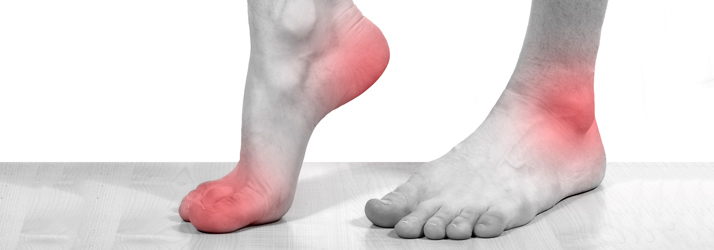Peripheral Neuropathy and Balance in Kingwood TX

We dont appreciate what we have until its gone. Balance is like that. Its like air. When you have it, you dont notice it. But when its gone, watch out!
- Dr. Eric Balcavage
This kind of quote kind of says it all. We take balance for granted when we have it but when we don't have it, we realize how difficult some of our daily activities can become. Loss of balance in Kingwood TX can be a terrifying thing making some people a prisoner in their own home.
How The Brain Controls Balance in Kingwood TX
Peripheral neuropathy is a leading cause of balance, the role peripheral neuropathy plays in your loss of balance, and how doctors like those authoring this guide are using functional medicine, functional neurology, Brain Based Therapy, and chiropractic care to help people with peripheral neuropathy restore the feeling in their feet, regain their balance, and get their quality of life back.
Let's start with some basics of how we maintain balance whether it's with walking or standing still.
Sensory Input
The ability to maintain balance depends on information that the brain receives from three different sources the eyes, the muscles and joints, and the vestibular organs in the inner ears. All three of these sources send information in the form of nerve impulses to the brain.
Input from the eyes
Nerve endings or sensory receptors in the back of the eye (retina) are sensitive to light. When light rays strike them, their nerve fibers send impulses to the brain with visual cues that aid in balance. For example, f a person is walking down the street, buildings appear to be aligned straight up and down.
Input from the muscles and joints
The input received by the brain from the muscles and joins comes from proprioception. Proprioceptors are sensory receptors that are sensitive to stretch or pressure in the tissue that surrounds them. These sensory impulses are then sent to the brain for cues on what the body is doing in that moment of time. Most important are the impulses that come from your neck, which indicate the bodys movement or sway relative to the ground while standing.
Input from the vestibular system
The vestibular system (inner ear) is a complex series of passageways and chambers within the bony skull. These chambers are filled with and surround by fluid. There are identical systems located in the right and left ear. Each inner ear has a hearing component (the cochlea) and a balance component (the vestibular apparatus consisting of three semicircular canals and otolith organs). Inside each fluid filled canal is a sensory receptor that responds to head movement. When the head moves, the fluid in the ear lags causing the sensory receptor to bend, which creates an impulse to the brain about your movement. When the vestibular apparatus on both sides of the head is functioning properly, they send symmetrical impulses to the brain. That is, the impulses coming from the right side agree with the impulses coming from the left side. When impulses are not symmetrical on the right and left sides, one can become off balance and report dizziness.
Central Nervous System Processing
All the sensory input concerning balance, from the eyes, from the muscles and joints, and from the two sides of the vestibular system, is sent to the brain stem, where it is sorted out and integrated with contributions from other parts of the brain.
Motor Output
After the brain processes all the information coming in regarding your movement and the environment around you, it must respond quickly and tell the body what to do for you to maintain balance and keep upright. It sends impulses back to muscles in your head, neck, eyes, legs, and the rest of your body to allow a state of balance to occur.
Motor Output To The Eyes
The impulses that go to the eyes coordinate their movement to produce clear vision during head movements. This is controlled automatically by the vestibular system. If this did not occur, anytime you moved, your vision would be blurry.
Motor Output To The Muscles And Joints
The impulses that are sent from the brain to the other muscles of the body control their movement so that balance is maintained whether a person is sitting, standing, walking, or playing a sport. Through practice and repetition, the impulses from the sensory receptors to the brain and then out to the muscles form a pathway. With repetition, it becomes easier for the impulses to travel over the same network or pathway, until maintaining balance during any activity become automatic.
Whew, that was quite a bit to take in.
The key point is that your feet play a critical role in helping you maintain your balance. Unfortunately, when you have peripheral neuropathy, you have damage to the nerve fibers in your feet (and the rest of your body). As it progresses, it typically affects more and more sensory fibers in the affected nerves. Loss of these fibers gradually causes difficulty with things like sensing the contour of the ground one is walking on, so that for example, you might not be able to feel a crack in the sidewalk and accidentally trip.
This type of loss of sensation can become so severe that you must literally stare at your feet to visually compensate for the lack of ability to FEEL where your feet/legs are. You may not be able to stand still if your legs and feet are too close together. This type of sensory loss is most pronounced at night or in the dark where the ability to compensate with vision is most limited.
The better the sensory perception in your feet the better balance you will likely have.
So that brings us to the next point and that is, if you have peripheral neuropathy what can you do about it?
OFFICE HOURS
Monday
7:30am - 6:00pm
Tuesday
7:30am - 6:00pm
Wednesday
7:30am - 6:00pm
Thursday
7:30am - 6:00pm
Friday
Closed
Saturday & Sunday
Closed
Clark Chiropractic & Wellness
562 Kingwood Dr
Kingwood, TX 77339


